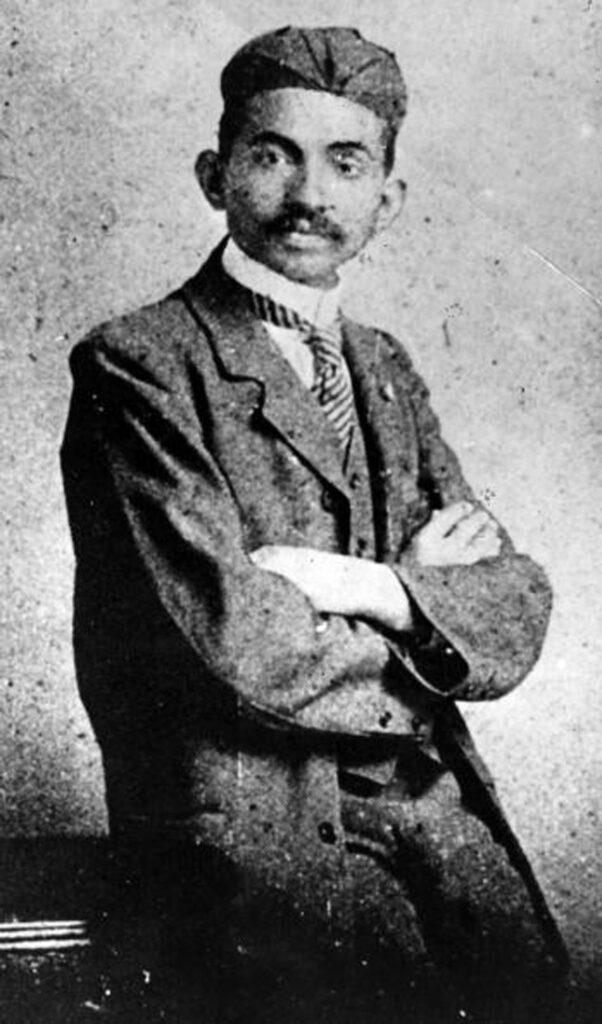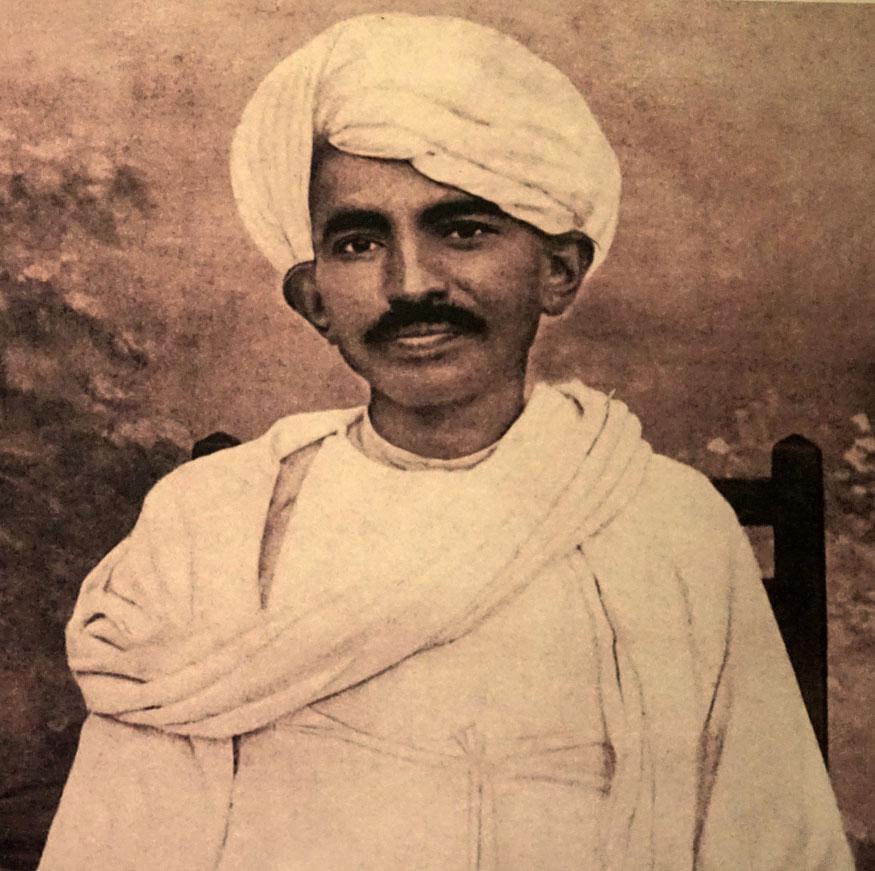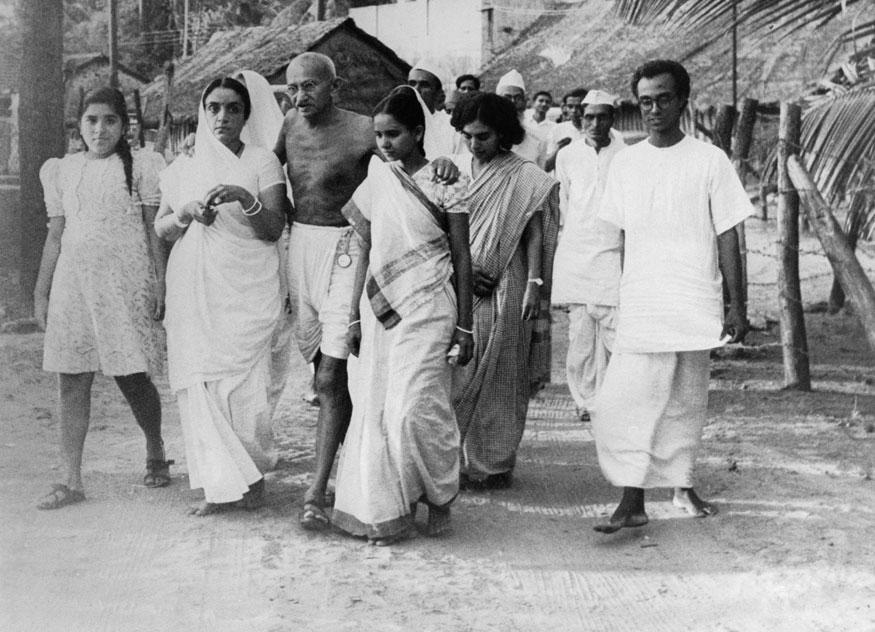The great Mahatma Gandhi, a hero of India, a man who through a campaign of non-violence, freed his country from the clutches of British Imperialists. He was not just a “father” of his nation, but for some, he was considered almost saintly. He also liked to sleep alone in beds with his grandnieces and other young women, and held some shockingly racist views toward other races. This article is about to shock some of readers. It might even offend some of you. But we also think by the time you’ve got to the end of this, you will have also changed your mind as how you think about Mr. Gandhi.
Mahatma Gandhi’s upbringing and early life
Before we get to that, here’s an abridged introduction to the man born Mohandas Karamchand Gandhi on October 2nd, 1869. He grew up in fairly comfortable surroundings seeing that his father held the position of Diwan (Chief minister) of the Indian state of Porbandar. His mother was said to be a very pious woman, which is where the young Gandhi discovered the beliefs of cherishing the simple things in life. The religious devotion he saw by his mother would foster him a sense of ethics that he later became famous for on a global scale. Things such as non-violence, tolerance of others’ beliefs, vegetarianism, and acts of self-purification, were his badge. They were also steeped in hypocrisy at times. His beliefs were put to the test when he went over to London to study. Before he left India, he swore to his mom to not fall for the enticements of modern life, to stay clear of women and meat, and generally to uphold the beliefs she’d taught him.

But while studying law in London, he witnessed late 19th-century industry and all the horrors that could come with it. The streets of London were certainly not paved with gold. Far from it, many Londoners with their ragged clothes and dirty faces didn’t seem to be enjoying Britain’s industrial wealth. Gandhi witnessed poverty, but he also witnessed activism there. It was the same when he went over to South Africa, where he saw much of the population living in abject poverty. Gandhi might have been an educated lawyer by this time, but that didn’t mean he wasn’t told like other Indians that because of his skin color he wasn’t allowed to walk on certain footpaths or enter certain buildings. There’s more to this story, but let’s just tell you the good Gandhi story first.

He was disgusted. There he was, an educated man who considered himself as much English as he was Indian but treated as a second class citizen by the Europeans. One time, he was kicked out of a train coach because of his race. Like many other people of color, his rights were taken away from him. On other occasions, he was beaten up for not making room for a white passenger. If that wasn’t bad enough, he was barred for staying at certain hotels even though he had the money to pay for them. The story goes that Gandhi understood the many wrongs committed by the imperialists. And so was at this juncture in his life when he decided he was going to bring about change. But his resistance in line with his religious beliefs, had to be peaceful. One of the most famous lines is, “Every revolution begins with a single act of defiance.” And this is how he began fighting for the rights of Indians. This is how he got a name for himself as an activist, which on one dark day in Durban, South Africa, almost got him lynched by a mob of angry white folks. He spent several years in South Africa, but he knew that India needed him. When he announced his departure from Africa, a statesman wrote, “The saint has left our shores.” This statesman was a white South African. He finished the sentence, “I hope forever.”

Back in India, Gandhi carried on fighting for people’s rights. He’d been beaten up, he’d been jailed, he’d been harangued and oppressed, and he still preached peace. He might have supported the british war effort, but he also never shied away from criticizing the British imperialists. Initially Mahatma Gandhi became one of the most powerful people in India. His form of Indian Nationalism was embraced by much of the country, most of the country in fact, and they started to believe that with the right will, the Indian people could be free of the British.

His activism got him arrested on march 10, 1922, and he spent the next two years behind bars, but he wasn’t done by any means. In the years to follow, he would lead many of the Indian people to peacefully revolt against many facets of the British rule. His followers – and there were many – went to prison for their acts of civil disobedience. In 1932, while in prison again, he undertook a now-famous fast over the disenfranchisement of those at the bottom of India’s caste system, people called the “untouchables.” When Indians saw how willing Gandhi was to die for his people, for the rights of the country’s poorest, it spread hope through the hearts of the nation.

Gandhi’s Demand for Self-Governance
During the Second World War, the Indian National Congress, led by Mahatma Gandhi, demanded self-governance from the British before committing Indian nationals to the battlefield. The Indian people had already suffered greatly in the war, with a staggering total of 2.5 million Indian casualties. Around 90,000 Indians lost their lives, emphasizing the sacrifices made by the Indian community. Gandhi’s demand for self-governance before further involvement in the war highlighted the urgency for India’s independence.
Amidst the war’s chaos, Mahatma Gandhi initiated the “Quit India Movement” even before the war’s end. This movement aimed to mobilize the Indian population against British rule and accelerate the process of gaining independence. Gandhi’s call for civil disobedience and non-violent protests inspired millions of Indians to rise against the British colonial authorities. The Quit India Movement became a significant turning point in India’s struggle for freedom.
Gandhi’s Controversial Views on Non-Violence
Gandhi’s commitment to non-violence extended to extraordinary levels, often challenging conventional wisdom. His controversial remarks during the war, such as suggesting that the British should not retaliate against the Nazis’ bombings, drew widespread condemnation. Gandhi believed in laying down arms and refusing to owe allegiance to the aggressors, even if it meant sacrificing lives. His unwavering moral absolutism faced criticism, particularly from those directly under attack.
In one of Gandhi’s most controversial statements, he said, “Hitler killed 5 million Jews. It’s the greatest crime of our time. But the Jews should have offered themselves to the butcher’s knife. They should have thrown themselves into the sea from cliffs… It would have aroused the world and the people of Germany… As it is, they succumbed anyway in their millions.” These provocative words pushed the boundaries of non-violence, raising eyebrows and igniting debates. Gandhi’s remarks seemed senseless to some, especially those who were under the threat of Nazi aggression.
With the benefit of hindsight, it is clear that following Gandhi’s directives during that time would have resulted in even greater horrors. Surrendering to Nazi Germany’s whims would have allowed further devastation and loss of life. Gandhi’s unconventional approach to non-violence, though driven by noble intentions, failed to consider the harsh realities of the war and the need for self-defense.
Another layer of controversy surrounding Gandhi is the allegations of his racism. Some critics argue that his views and actions displayed prejudice towards certain communities, including Africans. These allegations further complicate the perception of Gandhi and his assertions, prompting a more nuanced analysis of his legacy.
Unearthing Historical Controversies
In 2019, a debate stirred across the African nation of Malawi, igniting discussions about Gandhi’s legacy. Similarly, in Ghana during the same year, a Gandhi statue was removed from a university campus. These incidents might appear perplexing, considering the prevailing narrative of Gandhi fighting for people’s rights during his time in South Africa. However, it is crucial to delve deeper into history to understand the underlying reasons behind these actions.

Presently, in Ghana, a sentiment of disdain toward Gandhi has gained traction, reverberating across social media platforms. A prime example is the trending hashtag “#GandhiMustFall,” which encapsulates the prevailing sentiment. At first glance, this may seem like an extreme response, but it becomes more comprehensible when one becomes aware of some of the racially charged statements Gandhi made during his time in Africa.
Challenging the Idealized Image
Gandhi’s writings during his stay in Africa reveal a troubling aspect of his early beliefs. For instance, he once asserted that white people, despite their imperfections, should assert dominance as the “predominating race” in South Africa. It is essential to acknowledge that Gandhi’s exposure to British colonial rule in India seemingly influenced his perception of Europeans as inherently superior to black Africans. This notion of superiority was rooted in the idea of civilization, further widening the gap between races.
It is worth noting that Gandhi’s stance evolved over time, and he eventually became an advocate for equality and an anti-racist. However, it is important to confront and understand the historical context of his earlier viewpoints. In a letter addressed to the British, Gandhi summarized his belief that Indians were only marginally superior, if at all, to the “savages” or native Africans. These derogatory terms, including the use of the offensive term “Kaffir,” further exemplify the racial biases prevalent during that era.

In 1904, Mahatma Gandhi expressed his discontent regarding the cohabitation of Indians and “Kaffirs,” stating, “About the mixing of the Kaffirs with the Indians, I must confess I feel most strongly.” His belief was that the amalgamation of African and Indian populations would contribute to the further spread of diseases like the plague. Today, this particular aspect of Gandhi’s past has prompted scrutiny and criticism, with individuals calling him out as a hypocrite. They argue that while Gandhi advocated for the rights of Indians, he worked with the British government to segregate whites from blacks in South Africa, where he spent a significant part of his life.
Questioning Gandhi’s Consistency
Critics point to instances where Gandhi petitioned the colonial government in South Africa to ensure that Indians would not have to share queues with black individuals at post offices in Durban. He believed it was unfair that Indians were unable to queue with white individuals. Opponents argue that this indicates Gandhi’s selective perspective on racial equality, leading them to question his commitment to the broader cause.
Some individuals attempt to defend Gandhi, arguing that he was a product of his times. They claim that while he may not have consistently fought for what was right, his actions were influenced by the prevailing societal norms and beliefs. However, one would expect a person of high intelligence to possess an innate sense of right and wrong, transcending the limitations of their era.
Furthermore, there are claims that Gandhi was a member of the Aryan brotherhood, a group characterized by its emphasis on white and Indian superiority over Africans. It is important to note that the term “Aryan brotherhood” in this context refers to a distinct historical association and should not be confused with modern extremist groups. Supporters of this view argue that Gandhi’s belief in the hierarchy of races, placing whites and Indians above Africans, demonstrates his racist inclinations. They also contend that Gandhi attempted to erase African contributions from history and was willing to align with whites to ensure their domination.
To understand the extent of Gandhi’s alleged racism, one must consider various perspectives. Critics argue that his support for the Aryan brotherhood and his willingness to collaborate with white individuals to suppress Africans were indicative of his racial biases. These actions stand in stark contrast to his supposed advocacy for equality.
It is crucial to approach this debate with a nuanced understanding of historical context and individual complexities. Gandhi played a pivotal role in India’s independence movement and inspired numerous civil rights leaders worldwide. However, his controversial views on race present a challenge when evaluating his legacy.
The assessment of Gandhi’s character and principles should not solely revolve around his flaws but also consider the broader impact of his ideas and actions. While it is important to acknowledge his contributions to nonviolent resistance and social justice, it is equally vital to engage in critical discussions surrounding his controversial beliefs. Understanding Gandhi in his entirety allows for a more comprehensive evaluation of his legacy.
Gandhi’s Transformation: A Delicate Balancing Act
The extent of Gandhi’s ideological shift remains a subject of debate. During his advocacy for non-violent resistance, a crucial question emerges: Did Gandhi, while urging people to nonviolently resist the Germans, still harbor remnants of belief in superior races? This inquiry exposes the need to examine Gandhi’s mindset and the context in which he operated.
Gandhi’s time in South Africa confronts the notion that he was merely a product of his era. Prior to his arrival, black individuals had long been engaged in their struggle for rights. Therefore, Gandhi’s awareness of the violent oppression faced by a racially marginalized group challenges the argument that he was a mere reflection of prevailing sentiments.
Upon arriving in South Africa, Gandhi found himself immersed in a society where he encountered new dynamics and prejudices. The experience of sharing train carriages and queues with individuals he referred to as “coolies” left him profoundly disenchanted. This discontent came to light in 1906 when Gandhi, during the Zulu rebellion, aligned himself with the British, labeling it the “revolt of the Kaffirs.” These derogatory terms and his apparent belief in the superiority of certain races raised concerns about his racial views.
Although some argue that Gandhi underwent a transformative process and renounced his earlier beliefs, his critics contend that he failed to rectify his language and attitudes fully. Even if he held racist views based on racial hierarchies, his persistent use of derogatory terms like “coolies” and “kaffirs” to refer to African people remains a valid point of critique. This apparent lack of respect further fueled the controversy surrounding his legacy.
An illustrative incident occurred at a dinner party hosted by British imperialist Hugh Wyndham, 4th Baron Leconfield, where Gandhi’s actions spoke volumes about his attitude towards Africans. Seated beside members of the empire’s elite, he reveled in the evening’s ambiance while exhibiting a complete disregard for African attendees. This episode resonated with biographers, highlighting Gandhi’s selective regard for human rights and his failure to acknowledge Africans’ presence.
Gandhi’s personal life reveals a series of paradoxes that challenge the idealized image often associated with him. While his advocacy for human rights and an end to discrimination is commendable, his involvement in discriminatory practices raises uncomfortable questions. These paradoxes underscore the complexities of human nature and the challenges individuals face in aligning their personal beliefs with their public persona.
Examining Gandhi’s Contradictions and Controversies
Gandhi, a staunch believer in self-control and spiritual purity, expressed strong disapproval towards marrying solely for carnal gratification. He went as far as stating that those who engaged in such marriages were lower than even beasts. Having embraced celibacy himself at the age of 38, Gandhi’s personal life reflected his commitment to abstaining from sexual relationships. Despite his condemnation of casual sex and emphasis on self-restraint, allegations and controversies have arisen regarding his own conduct.
The Guardian newspaper’s portrayal of Gandhi’s interactions with young unmarried women as “weird, manipulative flirtations” has added fuel to the fire. These allegations suggest that Gandhi’s behavior towards young women contradicted his proclaimed principles of sexual purity. While historical records may reveal instances of questionable conduct, it is crucial to critically examine the veracity and context of such claims. The controversy surrounding Gandhi’s relationships with women has undoubtedly raised doubts about the consistency of his principles and actions.

In 2021, the toppling of Gandhi’s statue in California drew attention to the accusations leveled against him. The Organization for Minorities of India, a group opposing the statue’s restoration, claimed that Gandhi exploited his grandnieces and teenage girls under the guise of conducting “celibacy experiments.” These allegations strike at the core of Gandhi’s moral standing and his contributions to the treatment of women in India. To comprehend the significance of these claims, it is necessary to explore the historical context and different interpretations of Gandhi’s actions.
Gandhi’s impact on the treatment of women in India cannot be denied. His advocacy for women’s rights and involvement in various social reforms brought about significant changes in societal norms. However, the allegations of sexual exploitation raise concerns about the extent of his commitment to these ideals. Critics argue that Gandhi’s personal behavior contradicted the very principles he espoused, thereby casting a shadow over his contributions to gender equality.
The debate surrounding Gandhi’s sexual purity and his treatment of women continues to reverberate in modern times. Supporters of his legacy argue that his flaws should not overshadow his invaluable contributions to the freedom struggle and social justice. They contend that judging historical figures based on contemporary standards is an oversimplification that disregards the complexities of their era. On the other hand, those critical of Gandhi’s personal conduct emphasize the need for a nuanced understanding of historical figures, acknowledging their contradictions and their impact on society.
Gandhi, known for his pursuit of peace, has faced accusations of sexism, racism, and engaging in inappropriate behavior with young women. These tarnishing claims have labeled him a “predator,” undermining his image as a man of pure intentions. However, when serious allegations emerge, it becomes crucial to assess the evidence supporting such claims. This article delves into the controversies surrounding Gandhi, shedding light on his stance on birth control and exploring the incidents involving his grandniece and other young women. Furthermore, we will examine his troubled relationship with his wife, revealing the complexities of Gandhi’s personal life.
Gandhi’s perspective on birth control was rather unconventional. He opposed it, except when it involved individuals controlling their “animal passions.” In his view, excessive sexual activity would lead to mental and moral degradation. He expressed concerns that indulging in too much sex would render individuals “soft-brained, unhinged, in fact, mental and moral wrecks.” While this viewpoint may seem archaic and out of touch with modern understanding, it must be noted that societal attitudes towards sex and contraception were vastly different during Gandhi’s time.
Read More – JP Morgan: The Hero Who Rescued America Twice
Controversial Experiments with His Grandniece
During the 1930s, when Gandhi was an aging man, he embarked on a highly controversial experiment involving his young grandniece. He invited her to share a bed with him, explaining that it was an attempt to test his ability to control his own desires. This act, though disturbing, was not hidden from public knowledge. Gandhi openly acknowledged that it was a means to “test, or further test, his conquest of sexual desire.” It is important to recognize that such behavior is entirely unacceptable by today’s standards, and rightfully raises concerns about his ethical conduct.
Gandhi’s experiments extended beyond his grandniece, involving other young women and girls residing at the ashram. Although intercourse did not occur, he pushed the boundaries and subjected himself to various tests of self-restraint. The details of these interactions are contentious and continue to be a subject of debate. It is imperative to approach this topic with sensitivity, acknowledging that the actions undertaken by Gandhi were highly inappropriate and not justifiable under any circumstances.
Throughout his life, Gandhi’s relationship with his wife was tumultuous. Reports suggest that he displayed a lack of affection towards her and even admitted to being unable to bear looking at her face. This strained dynamic raises questions about the nature of their marriage and the emotional support Gandhi provided to his spouse. Furthermore, Gandhi’s denial of life-saving drugs to his wife adds another layer of complexity to their relationship, revealing a distressing disregard for her well-being.
Gandhi’s two-week celibacy experiments drew significant criticism and continue to be a topic of debate. Despite the backlash, he remained steadfast in his beliefs. These experiments were a manifestation of Gandhi’s commitment to self-control and his belief that practicing celibacy could lead to spiritual enlightenment.
Gandhi’s conservative beliefs regarding sex and gender have been highly controversial. One example that highlights his controversial stance is his response to women being attacked by men on the street. Shockingly, Gandhi suggested that the victims should shave off their hair to make themselves less attractive to men. This viewpoint placed the blame on women rather than addressing the root cause of male violence.
Another controversial statement made by Gandhi was his assertion that a woman’s menstruation cycle was a “manifestation of the distortion of a woman’s soul by her sexuality.” This perspective is widely criticized as being rooted in misogyny and lacking scientific basis. It reflects a deep-seated misunderstanding of the natural biological processes that women undergo.
Accusations of racism and sexually-focused predatory behavior have also been levied against Gandhi. Some argue that his actions and writings demonstrate racist undertones, while others believe that these claims overshadow the positive impact he had on humanity. It is important to analyze Gandhi’s beliefs and actions within the historical and social context in which they occurred, considering the complexities of his character.
While Gandhi’s controversial views and actions cannot be dismissed, it is crucial to recognize the positive aspects of his legacy. He played a pivotal role in India’s struggle for independence, advocating for non-violent resistance and civil rights. Gandhi’s philosophy of non-violence inspired millions and continues to influence social and political movements worldwide.











